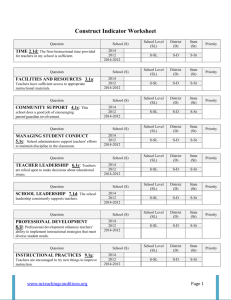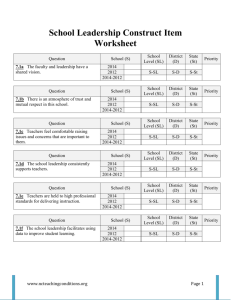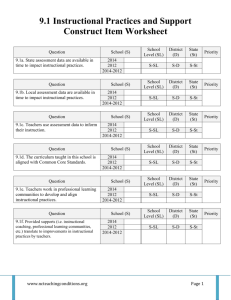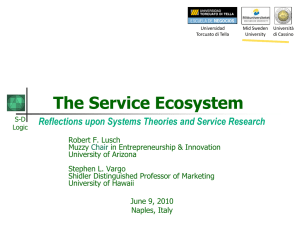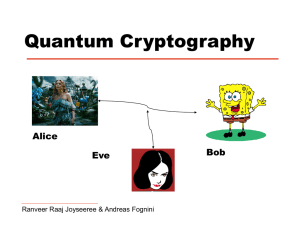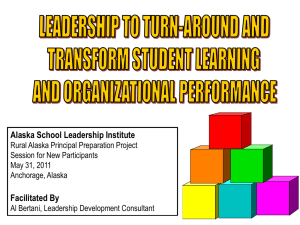Participant`s Packet
advertisement
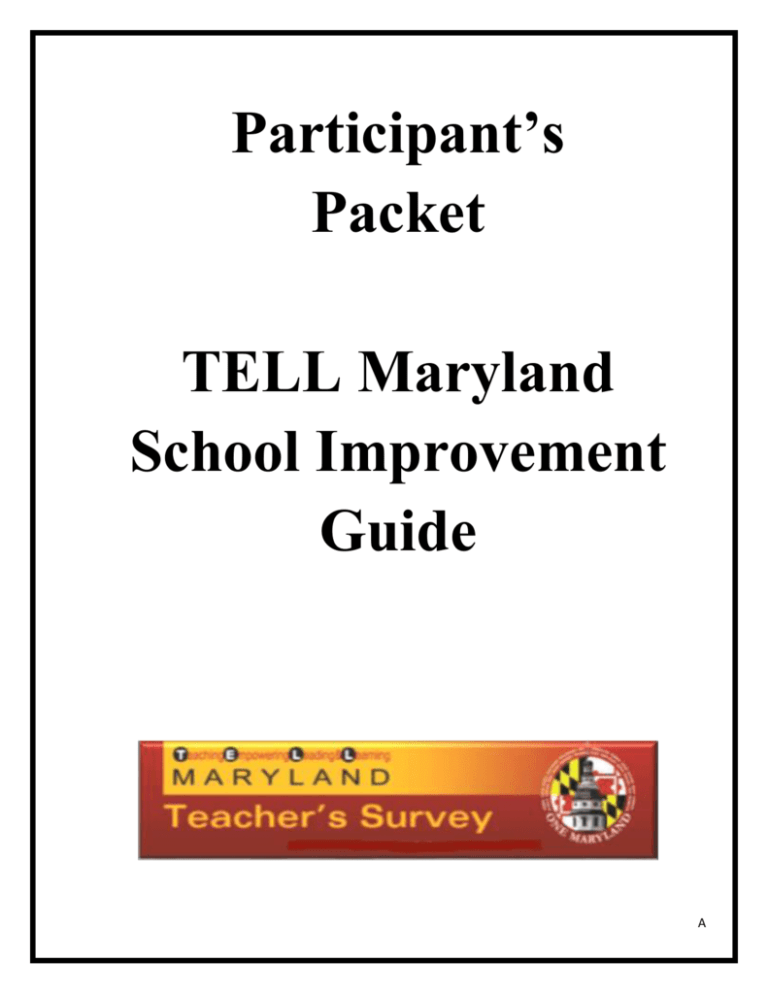
Participant’s Packet TELL Maryland School Improvement Guide A Day / Night Partners ……………………………………………………………………… Day ………………………………………………………………………. Night B Construct Reflections Connector Read the Construct titles below, and spend five minutes reflecting on how well these working conditions are in place in your own school. Rate each construct on a 4 scale, with 4 being the highest, then write a brief explanation as to why you believe this is true. 4 – These conditions are strongly beneficial to effective teacher practice and promote student learning at high levels 3 – These conditions are beneficial to effective teacher practice and promote student learning 2 – These conditions do not benefit effective teacher practice or promote student learning 1 – These conditions hinder effective teacher practice and student learning CONSTRUCT # RATIONALE Positive Aspects Challenging Aspects TIME FACILITIES AND RESOURCES COMMUNITY SUPPORT MANAGING STUDENT CONDUCT TEACHER LEADERSHIP SCHOOL LEADERSHIP PROFESSIONAL DEVELOPMENT INSTRUCTIONAL PRACTICES AND SUPPORT C TELL Maryland Survey: Effectively Using the Survey Results Teaching conditions are critical to educator success and satisfaction. The TELL Maryland Survey provides data to schools and districts in Maryland about whether educators have the supportive school environments necessary for them to remain working and be successful with students. This unique data represents the perceptions of those who understand these conditions best—the educators who experience them every day. But assessing teaching conditions is not like looking at other more neutral and quantifiable data points like student test scores, class size, etc. Getting honest, authentic input and dialogue, especially in schools where the basic building blocks of positive conditions— trust, time and leadership—are not in place can be challenging. Using information in a positive way toward school improvement is critical. Please consider the following when analyzing and using the TELL Maryland Survey. 1. Teaching conditions are an area for school improvement, not accountability. Because teaching and learning conditions are about schools, no one individual should be held solely accountable for the status of the school culture. Rather data gathered should be used to guide school improvement planning with schools then assessed on their progress toward implementing collectively developed reforms. If individual school administrators or teachers are assessed in these areas, this survey should serve as one of multiple data artifacts. Individuals can be encouraged to create specific performance goals about their role in creating and implementing data-driven strategies to improve teacher working conditions that are part of the school improvement plan. 2. Teaching and learning conditions are not about any one individual and it will take a community effort to improve. The principal holds a unique and important place within the school community and can have a significant impact on the professional culture in which teachers work. However, many aspects of teaching conditions are beyond the principal’s control. Broader social trends, federal, state and district policies all impact how educators view and operate within their school and classroom. Conditions are about schools, not about individuals. So no one person should be viewed as responsible for creating or reforming school culture alone. No questions on this survey were about the principal. All questions were about school leadership, defined specifically as an individual, group of individuals or team within the school. 3. Perceptual data are real data. While the survey results are perceptual data from educators about the presence of important teaching conditions, it does not mean it is not “valid” or as important as other data sources. Educator D perceptions of the culture and context of their school have been linked in a number of studies to student learning, future employment plans, efficacy and motivation. Analyzing and using this information to improve schools is critical and needs to be a part of reform efforts at the school, district levels. Educators’ perceptions are their reality. However, other data should be used to triangulate these findings and provide a better understanding of these perceptions such as instructional expenditures, proportion of teachers working out of field, teacher/pupil ratio, etc. 4. Conversations need to be structured and safe. Conversations about teaching and learning conditions are often the lifeblood of teachers’ lounges. Having data-driven dialogue about the findings of the survey, the root causes of educator perceptions, and potential reforms requires structure, facilitation, ground rules and the ability to separate issues from individuals. These are not easy conversations, and they become harder if they are not tackled systematically and predictably when all can participate in a meaningful and safe way. 5. Identify and celebrate positives as well as considering areas for improvement. Educators have tremendous pride in the work they do and all want to work in a school that allows them to do their best work. And all schools have successes to draw upon as they assess and improve their context. Ensuring that positives are acknowledged and celebrated, while issues are identified and addressed, is an important part of moving forward. 6. Create a common understanding of what defines and shapes teaching and learn conditions. Anything and everything might be considered a part of and influence on teaching and learning conditions. Research shows that broader social trends, media coverage, respect for the profession, local and state policies, etc. can all influence teachers’ perceptions of their conditions and ultimately their motivation and efficacy as educators. The survey provides input from educators on a host of important research-based teaching conditions. Other areas may be worthy of further investigation, such as teaching assignments, curricular support, assessments and accountability, parent and community support, etc. These questions and responses are a starting point, not an ending point for understanding what is important to teachers for them to do their best work. 7. Focus on what you can solve. Many issues that shape teaching conditions within a school or district are outside of their control, such as federal and state assessment policies, funding, etc. School improvement planning should focus on areas that can be addressed by the school community. District barriers to school-based solutions should be identified and constructive conversations across schools could occur locally. Other influences such as federal and state policy, broader social and community context, are areas for the school to think about in concert with others. A plan with solutions that cannot be reached through the efforts of the school community is not likely to be successful. 8. Solutions can be complex and long term. E Teaching and learning conditions are cumulative and engrained. It took many years and faculty members to create them and it will take a similar amount of time to reform them. Some solutions may be inexpensive and simple to address, like having a more consistent means of communicating amongst the faculty, while others are resource intensive (class size reduction, integration of technology) or long range (building trust, creating authentic Professional Learning Communities). A school improvement plan must pay attention both to short and long term issues to successfully improve the school environment. F “Effectively Using the Survey Results” Take Away’s and Reflections Which items did you view as being most critical for your success? Explain how they fit your context. Were there any sections that you disagreed with? What was the main source of conflict for you? Which item do you think would be the easiest to implement at your school? Why? Which item do you think would be the most difficult to implement at your school? Why? G TELL Vocabulary List TELL – Teaching, Empowering, Leading and Learning Teaching and Learning Conditions – the systems, relationships, resources, environments and people in your school that affect your ability to teach (or learn) at a high level Construct – a grouping of several specific questions, all dealing with the same topic. o Time, Facilities and Resources, Community Support and Involvement, Managing Student Conduct, Teacher Leadership, School Leadership, Professional Development, Instructional Practices and Support, and New Teacher Support Item – a specific individual question Individual Item Prompts – a series of questions that help guide a group in thinking about the data associated with one specific question Drill down – breaking the data into smaller pieces to analyze it for the purpose of changing one specific working condition Rate of Agreement – the percentage of people who said they agreed or strongly agreed that a working condition was in place Neither Agree nor Disagree – the percentage of people who did not feel the working condition was or was not in place. They could be ambivalent, they may not have understood the question, or they may not have experience in that arena H Construct Indicator Worksheet Question TIME 2.1c: The non-instructional time provided for teachers in my school is sufficient. Question FACILITIES AND RESOURCES 3.1a: Teachers have sufficient access to appropriate instructional materials. Question COMMUNITY SUPPORT 4.1c: This school does a good job of encouraging parent/guardian involvement. Question MANAGING STUDENT CONDUCT 5.1e: School administrators support teachers’ efforts to maintain discipline in the classroom. Question TEACHER LEADERSHIP 6.1c: Teachers are relied upon to make decisions about educational issues. Question SCHOOL LEADERSHIP 7.1d: The school leadership consistently supports teachers. Question PROFESSIONAL DEVELOPMENT 8.1k: Professional development enhances teachers’ ability to implement instructional strategies that meet diverse student needs. Question INSTRUCTIONAL PRACTICES and Support 9.1f: Teachers are encouraged to try new things to improve instruction. School (S) 2015 2013 2015-2013 School (S) 2015 2013 2015-2013 School (S) 2015 2013 2015-2013 School (S) 2015 2013 2015-2013 School (S) 2015 2013 2015-2013 School (S) 2015 2013 2015-2013 School (S) 2015 2013 2015-2013 School (S) 2015 2013 2015-2013 School Level (SL) District (D) State (St) S-SL S-D S-St School Level (SL) District (D) State (St) S-SL S-D S-St School Level (SL) District (D) State (St) S-SL S-D S-St School Level (SL) District (D) State (St) S-SL S-D S-St School Level (SL) District (D) State (St) S-SL S-D S-St School Level (SL) District (D) State (St) S-SL S-D S-St School Level (SL) District (D) State (St) S-SL S-D S-St School Level (SL) District (D) State (St) S-SL S-D S-St Priority Priority Priority Priority Priority Priority Priority Priority I 2.1 Time Construct Item Worksheet Question 2.1a. Class sizes are reasonable, such that teachers have time to meet the educational needs of all students. Question 2.1b. Teachers are allowed to focus on educating students with minimal interruptions. Question 2.1c. The non-instructional time provided for teachers in my school is sufficient. Question 2.1d. Efforts are made to minimize the amount of routine paperwork that teachers are required to do. Question 2.1e. Teachers have sufficient instructional time to meet the needs of all students. Question 2.1f. Teachers are protected from duties that interfere with teachers’ essential role of educating students. Question 2.1g. Teachers have time available to collaborate with colleagues. School (S) 2015 2013 2015-2013 School (S) 2015 2013 2015-2013 School (S) 2015 2013 2015-2013 School (S) 2015 2013 2015-2013 School (S) 2015 2013 2015-2013 School (S) 2015 2013 2015-2013 School (S) 2015 2013 2015-2013 School Level (SL) District (D) State (St) S-SL S-D S-St School Level (SL) District (D) State (St) S-SL S-D S-St School Level (SL) District (D) State (St) S-SL S-D S-St School Level (SL) District (D) State (St) S-SL S-D S-St School Level (SL) District (D) State (St) S-SL S-D S-St School Level (SL) District (D) State (St) S-SL S-D S-St School Level (SL) District (D) State (St) S-SL S-D S-St Priority Priority Priority Priority Priority Priority Priority J Construct Item Worksheet Question School (S) 2015 2013 2015-2013 Question School (S) 2015 2013 2015-2013 Question School (S) 2015 2013 2015-2013 Question School (S) 2015 2013 2015-2013 Question School (S) 2015 2013 2015-2013 Question School (S) 2015 2013 2015-2013 Question School (S) 2015 2013 2015-2013 School Level (SL) District (D) State (St) S-SL S-D S-St School Level (SL) District (D) State (St) S-SL S-D S-St School Level (SL) District (D) State (St) S-SL S-D S-St School Level (SL) District (D) State (St) S-SL S-D S-St School Level (SL) District (D) State (St) S-SL S-D S-St School Level (SL) District (D) State (St) S-SL S-D S-St School Level (SL) District (D) State (St) S-SL S-D S-St Priority Priority Priority Priority Priority Priority Priority K What is working/not working? EXAMPLE ITEM to EXAMINE POSITIVE FACTORS District gives protected work days and ½ days for PLCs EFFECT ON SCHOOL/MY TEACHING Dedicated, protected group planning time MOVING FORWARD Expand my interaction to include folks from other schools to get more input and ideas Be prepared to maximize this planning time 2.1 G Teachers have time available to collaborate with their colleagues. Front office is good about turning away parents who come unannounced Keeps my time protected. Allows me more time to plan with colleagues Sincerely thank the front office staff for their help. Administration does a good job of only calling meetings when it is absolutely necessary, and gives us notice. The meetings are more engaging and welcomed. My time is protected. Thank the administration. Reinforce the steps they are taking. Be committed to engaging in the meetings when they are called. CHALLENGING FACTORS EFFECT ON SCHOOL/MY TEACHING MOVING FORWARD Kids are coming to me during my planning time to get additional help It is helping the kids, but hurting my planning and preparation with colleagues Designate specific days of the week as offlimits to students Subs are not available so we often have to cover other classes during our planning Often unexpected and really hurts my planning time and scheduling of important activities with colleagues Can we develop a rotating system within the school so we know better when we will be asked? Is it equitable? Not using my time as efficiently as I could be. Causing me to need more protected time than necessary to accomplish goals Chart what I am doing with my time to determine where I am inefficient. Work with veteran teachers and administrators to consider different approaches L What is working/not working? ITEM TO EXAMINE POSITIVE FACTORS CHALLENGING FACTORS EFFECT ON SCHOOL/MY TEACHING EFFECT ON SCHOOL/MY TEACHING MOVING FORWARD MOVING FORWARD M What is Ideal? What are the Challenges? Item: 2.1 G: Teachers have time available to collaborate with their colleagues. WHAT WOULD THE IDEAL LOOK LIKE? WHAT ARE THE CHALLENGES? Teachers never have to cover other teachers’ classes. Not practical. Teachers are never asked to a last minute meeting for a child study/local screening meeting. Knowing when manifestations are due School team/grade level/subject area meetings are efficient and pertinent. Everyone gets along and contributes equally. Skill of facilitator, relationships There will be times teachers must cover for one another Scheduling all parties ahead of time and keeping everyone up to speed Needs of staff are different OVERCOMING CHALLENGES? Put a rotation in place for teacher coverage so the amount of times each teacher is called on is equitable. Reward teachers who do cover other classes. Reflect on the meeting process and improve the efficiency of the process. Mandate teachers are notified ahead of time. Teachers are chosen that work with the child. The process is equitable for teachers. Provide an outline for each kind of meeting, perhaps a model of what the meeting should look like. Make some meetings optional for skilled staff. N What is Ideal? What are the Challenges? Item: WHAT WOULD THE IDEAL LOOK LIKE? WHAT ARE THE CHALLENGES? HOW DO WE OVERCOME THE CHALLENGES? O Graffiti Wall Ideal Item _____________________________ CHALLENGE 1 CHALLENGE 2 CHALLENGE 3 Ways to Overcome Ways to Overcome Ways to Overcome P Item Prompt Discussion Record Reflective Question Key Facts What is in our Control? Moving Forward Q School Improvement Initiative Objective: Teacher’s planning time is held sacred for PLC work. What does success look like? All Teachers will meet daily and uninterrupted in their subject or grade level PLC to plan differentiated, rigorous daily and unit plans, analyze student work, and create assessments. What steps are What must be How will we What resources By when? needed? included for know we are needed? With whom? success? succeeded? Understand clear meeting structure and processes. Create a coverage schedule Create a set meeting place and schedule A facilitator, reporter and recorder An agenda for each meeting Everyone feels the time was well spent A log of agendas Everyone participates equally PLC facilitator training Team leaders take the Oct. 15th facilitator’s training offered by the district All teachers must participate No teacher has covered more than 1 class a month Someone to make the schedule Administrator or Department Chair, by Oct.1. time before or after the meeting for personal needs and student mini-conferencing time for content/grade level, Child Study/local screening meetings parent conferencing, and administrative business We have a place to meet and a set schedule that we adhere to for 2 months in a row. Space Someone to make the schedule Principal will assign the place for all meetings Administrator will create meeting schedule with dept. chairs How will we maintain our success? We all pledge to honor our meeting times and to create true professional learning communities. R School Improvement Initiative Objective: What does success look like? What steps are needed? What is included? How will we measure success? What resources are needed? By when? With whom? How will we maintain our success? S Sample Change an Ideal Situation into an Objective Ideal Situation Ex. Teachers never have to cover other teachers’ classes. Objective Ex. Teachers’ planning time is held sacred for PLC work. T 2+2=4 Goal Setting Thinking about our objective, what one step is most critical to our success in making this goal a reality? Find someone with a different idea and record it below. Now, share your two ideas with a new partner, and record their two ideas. U Meeting Evaluation Meeting Evaluation Your feedback is important to continuously improve our dialogue and address teaching and learning conditions. Please rate the following from Strongly Disagree to Strongly Agree: 1. The presentation was clear and easy to understand. SA A N D SD 2. The presenters were prepared. SA A N D SD 3. We utilized the TELL Maryland Survey data to engage in data driven dialogue. SA A N D SD 4. All educators were engaged in the dialogue and activities. SA A N D SD 5. Presenter/participant interaction was sufficient. SA A N D SD 6. The materials provided were easy to understand. SA A N D SD 7. I was given enough time to do the activities. SA A N D SD Some things I thought were very helpful: Some things I thought could use improvement: Additional Comments or Additional Support the District Could Provide: V
